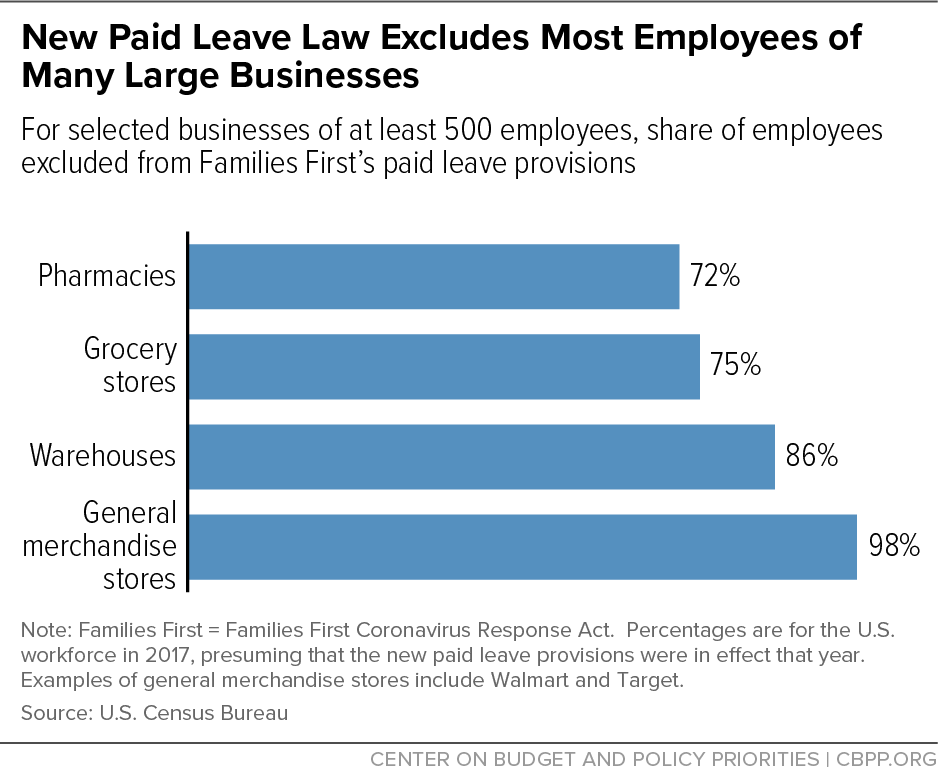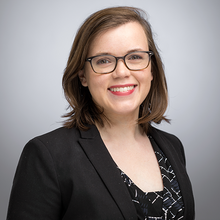Commentary: Policymakers Should Expand Emergency Paid Leave in Next Coronavirus Package
End Notes
[1] National Partnership for Women and Families, “Know Your Rights: Emergency Paid Sick Days and Paid Leave for Child Care and Coronavirus,” April 2020, https://www.nationalpartnership.org/our-work/resources/economic-justice/know-your-rights-emergency-paid-sick-days-and-paid-leave.pdf.
[2] The Center for American Progress estimates that “68 million to 106 million private sector workers may be excluded from coverage due to the law’s exemptions and broad regulations issued by the Trump administration.” Sarah Jane Glynn, “Coronavirus Paid Leave Exemptions Exclude Millions of Workers From Coverage,” Center for American Progress, April 17, 2020, https://www.americanprogress.org/issues/economy/news/2020/04/17/483287/coronavirus-paid-leave-exemptions-exclude-millions-workers-coverage/.
[3] Alyssa Fowers and Shelly Tan, “The new sick leave law doesn’t help the workers that need it the most,” Washington Post, March 19, 2020, https://www.washingtonpost.com/graphics/2020/national/sick-leave-workers-coronavirus/.
[4] U.S. Census Bureau, “2017 SUSB Annual Datasets by Establishment Industry,” March 2020, https://www.census.gov/data/datasets/2017/econ/susb/2017-susb.html.
[5] David Madland et al., “How the Federal Government Can Protect Essential Workers in the Fight Against Coronavirus,” Center for American Progress, April 8, 2020, https://www.americanprogress.org/issues/economy/news/2020/04/08/482881/federal-government-can-protect-essential-workers-fight-coronavirus/.
[6] Christopher Ingraham, “Why many ‘essential’ workers get paid so little, according to experts,” Washington Post, April 6, 2020, https://www.washingtonpost.com/business/2020/04/06/why-do-so-many-essential-workers-get-paid-so-little-heres-what-economists-have-say/.
[7] Liz Scheltens, “One policy that changes the coronavirus math,” Vox, March 27, 2020, https://www.vox.com/2020/3/27/21196932/paid-sick-leave-coronavirus.
[8] Jeffrey C. Mays and Andy Newman, “Virus Is Twice as Deadly for Black and Latino People Than Whites in NYC,” New York Times, April 8, 2020, https://www.nytimes.com/2020/04/08/nyregion/coronavirus-race-deaths.html.
[9] Chye-Ching Huang and Roderick Taylor, “How the Federal Tax Code Can Better Advance Racial Equity,” CBPP, July 25, 2019, https://www.cbpp.org/research/federal-tax/how-the-federal-tax-code-can-better-advance-racial-equity; Note: “Latino” generally refers to people whose origins are geographically located in Latin America, while “Hispanic” is not tied to geography but rather refers to those who have Spanish-speaking origins. In the Current Population Survey, the Bureau of Labor Statistics asks respondents to self-identify as “Hispanic, Latino, or Spanish” (this is asked in a single question).
[10] U.S. Bureau of Labor Statistics, “Current Population Survey Table 18: Employed persons by detailed industry, sex, race, and Hispanic or Latino ethnicity,” updated January 22, 2020, https://www.bls.gov/cps/cpsaat18.htm.
[11] U.S. Bureau of Labor Statistics, “Current Population Survey Table 11: Employed persons by detailed occupation, sex, race, and Hispanic or Latino ethnicity,” updated January 22, 2020, https://www.bls.gov/cps/cpsaat11.htm.
[12] Jaclyn Diaz, “Big Business Covid-19 Paid Leave Exemption May Get Another Look,” Bloomberg Law, March 31, 2020, https://news.bloomberglaw.com/daily-labor-report/big-business-covid-19-paid-leave-exemption-may-get-another-look.
[13] Jennifer Ortakales, “Here’s how a new law giving workers paid leave amid coronavirus will affect you,” Business Insider, March 20, 2020, https://www.businessinsider.com/coronavirus-paid-leave-bill-hr6201-means-employees-businesses-2020-3.
[14] Daniel Schneider and Kristen Harknett, “Estimates of Workers Who Lack Access to Paid Leave at 91 Large Service Sector Employers,” U.C. Berkeley: The Shift Project, March 2020, https://shift.berkeley.edu/files/2020/03/Estimates-of-Workers-Who-Lack-Access-to-Paid-Sick-Leave.pdf.
[15] Bureau of Labor Statistics, “National Compensation Survey: Private Industry Workers, Table 31A,” March 2019, https://www.bls.gov/ncs/ebs/benefits/2019/ownership/private/table31a.pdf.
[16] Ibid.
[17] Roselyn Miller, Brigid Schulte, and Haley Swenson, “Which Companies Still Aren’t Offering Paid Sick Days?” New America, updated April 15, 2020, https://www.newamerica.org/better-life-lab/reports/which-companies-still-arent-offering-paid-sick-days/.
[18] U.S. Department of Labor, “Temporary Rule: Paid Leave under Families First Coronavirus Response Act, April 1, 2020, https://www.dol.gov/agencies/whd/ffcra.
[19] Some health care and emergency response workers will have employer-provided sick days, but others will not, such as many contractors cleaning medical facilities. Among those with employer-provided sick days, most workers accrue fewer than ten days per year, and some will have already used up their sick days or will have only begun to accrue them.
[20] The law cited only Title 1 of the Family and Medical Leave Act (FMLA) in describing which federal employees may receive paid family leave, though most federal employees are covered by Title 2 of FMLA. The law did not exclude any federal agencies from paid sick leave and there is no apparent policy reason for excluding those who happen to be listed under a different title.
[21] U.S. Bureau of Labor Statistics, “Quarterly Data Series on Business Employment Dynamics: Table F,” updated January 29, 2020, https://www.bls.gov/web/cewbd/table_f.txt.
[22] Sharon Parrott et al., “Immediate and Robust Policy Response Needed in Face of Grave Risks to the Economy,” CBPP, March 19, 2020, https://www.cbpp.org/research/economy/immediate-and-robust-policy-response-needed-in-face-of-grave-risks-to-the-economy.
[23] U.S. Bureau of Labor Statistics, “Quarterly Data Series,” op. cit.


